We all know the first pieces of equipment we should purchase: the mask, the suit, the regulator, and so on. Yet, seemingly less important pieces of equipment are often neglected. Aside from the obvious bits of gear that are required to actually go diving, there are other key accessories that every diver should be equipped with, no matter their experience level. Find out if you’re already carrying these essentials by reading through our product recommendations and buyer’s advice guide.
Product Recommendations
#1 Delayed Surface Marker Buoys (DSMB)
DiveSmart 6ft Scuba Diving Open Bottom Surface Marker Buoy
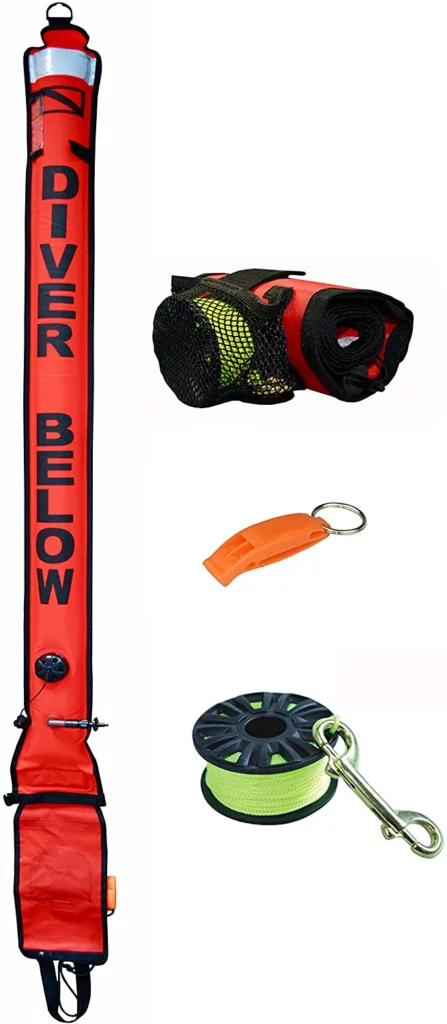
The DiveSmart 6ft DSMB offers the diver a very high visibility DSMB. Coming in at 6ft, with a reflective stripe as well as pockets for light attachment, this a DSMB that will ensure you are seen – this is typified by the fact that it even comes with an attached whistle! It is an open bottom design but also comes with an aeration tube allowing you to experiment with different methods of inflation.
Features
- 5 signalling methods: reflective band, flashlight/torch velcro strap, strobe light holder, “Diver Below” markings and attached whistle.
- Made from a 210D Nylon Fabric with a TPU coating for added strength, with an over-pressure valve.
- Open bottom design utilizes your second stage to inflate. Aeration tube also allows for oral/LPI inflation.
- Weighted bottom to prevent surface spilling.
XDEEP Closed 140cm DSMB
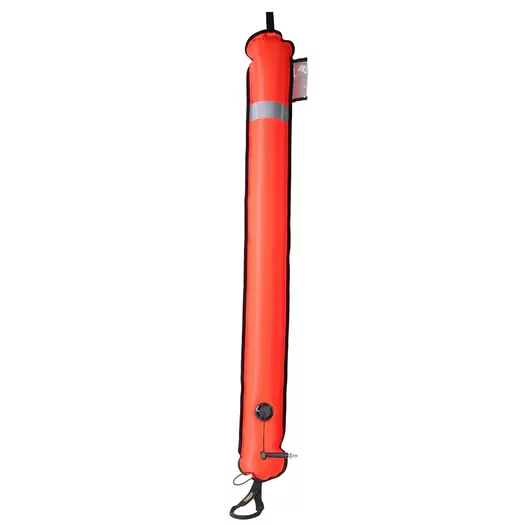
XDeep’s Closed DSMB is the perfect choice for those wanting maximum safety and effectiveness. Its closed cell design ensures that it will function in the event it collapses on the surface. The aeration tube for oral/LPI inflation is the optimum method of deployment, maximising safety and gas efficiency. This model comes with a message pocket which is invaluable for technical divers who need to communicate with surface support crews.
Features
- Closed cell design.
- Oral/LPI inflation.
- Message pocket.
- Reflective strip.
- Over-pressure valve.
- 140cm tall.
Apeks LifeLine Finger Spool
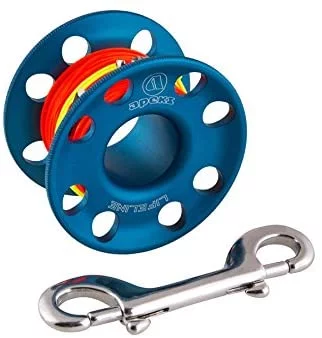
If buying a DSMB without a spool, then you will need to invest in one separately. In terms of the best spool, the Apeks Lifeline Finger Spool ranks at the top. It is a 45m long spool with high quality line. The line is not over-wound, allowing for more to be added if necessary, and is sewn instead of tied, thereby increasing tensile strength. The line is orange, making it clear to be seen in low visibility environments. The spool itself is flared, allowing for better grip and ease of unwinding, even in thick dry gloves.
Features
- Unique flared design to allow ease of winding whilst wearing gloves and an outer grip for ease of use.
- A large diameter centre hole for use in cold water whilst wearing gloves.
- Available in a range of colours.
- Anodised coating.
- Spool is not over-wound, enabling additional line to be added if required.
- Line is sewn instead of tied to increase strength.
- Orange line is best for low light conditions.
#2 Dive Knife
EezyCut Trilobite Line Cutter
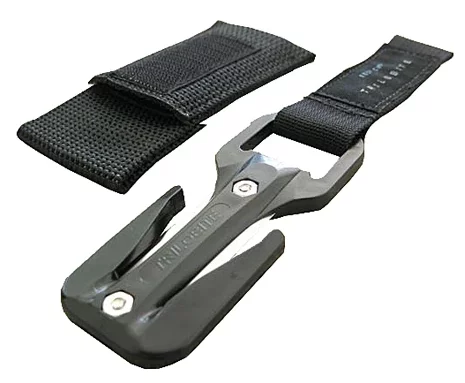
The EezyCut Trilobite Line Cutter is a favourite of many divers of all levels of experience and qualification. Its small size and protected blades makes for easy and safe operation. It also comes with spare replacement blades. Despite being a line cutter, the EezyCut can also make quick work of harness webbing, allowing the diver to quickly cut their buddy out of their harness in a matter of seconds in a rescue scenario. It can be mounted either on the wrist, harness, or it can be stored in an accessory pouch or pocket if so desired. The sheath is a tension sheath with a simple velcro flap, making for very easy drawing and replacement.
Features
- Comes with replaceable spare blades.
- Can be mounted to harness webbing or computer strap.
- Line cutter with protected blade.
- Available in a range of colours.
Aqualung Argonaut Dive Knife
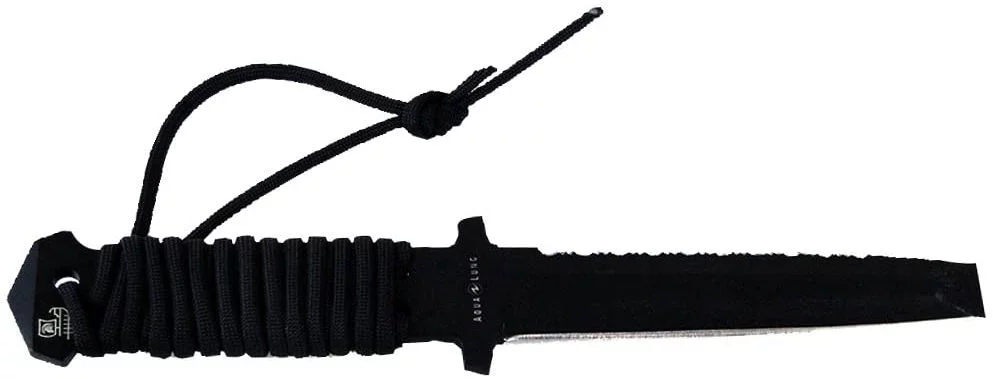
The Aqualung Argonaut is a top of the range, corrosion-resistant, heavy duty titanium dive knife. This is the perfect knife for those needing to cut through thick anchor lines or similar materials. Its slightly longer length offers increased cutting efficiency too. Its blunt tip offers greater safety also. This is the best dive knife for divers who dive in very demanding conditions with a high risk of entanglement.
Features
- Blade and Handle are made of 4mm thick Titanium with an EDP coating. The handle is double wrapped in 5mm paracord.
- The blade comes in 2 styles, Spartan and Blunt.
- The butt of the handle comes to a point for hammering, braking and crushing.
#3 Underwater Compass
DGX Tech Compass
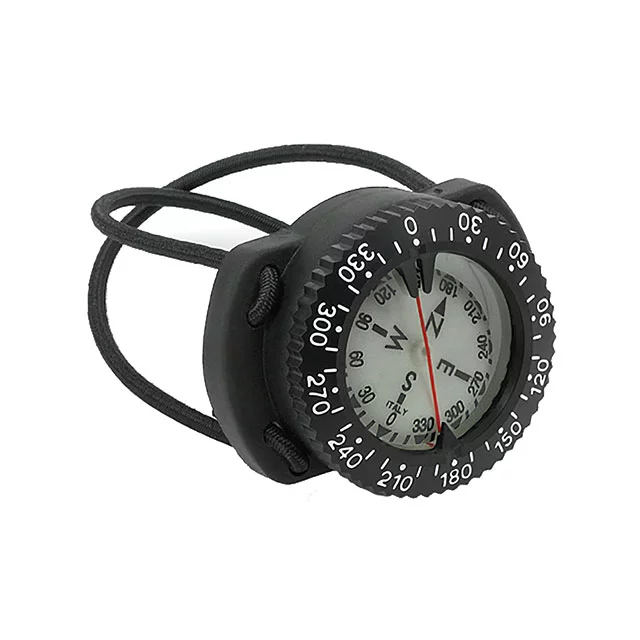
The DGX Tech Compass is a minimalistic, bungee mounted compass. The face is very easy to read, with an additional side view window for easier navigation. It is also tilt compensating, allowing for greater accuracy and easier use.
Features
- Easy-To-Read Luminescent Face.
- Top and Side Reading option.
- Low Profile Bungee Mount.
- Northern Hemisphere Calibrated.
- Wrist mount.
#4 Spares & Tool Kit
Innovative Scuba Concepts Deluxe Diver Tool & Repair Kit
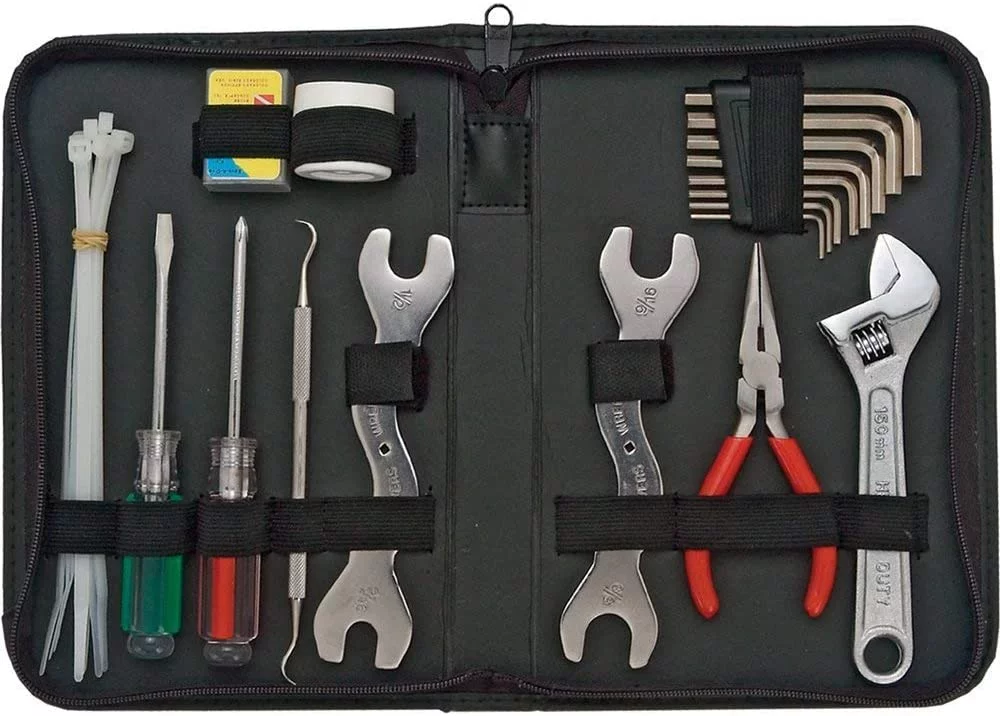
This pre-prepared tool and repair kit is an excellent complement to the diver. It comes with a variety of tools, covering you for almost all of the jobs you’ll ever need to do. On top of this it also comes with silicone grease and an o-ring pick, making o-ring maintenance and replacement much easier.
Features
- Cable ties.
- O-ring pick.
- Silicone grease.
- Adjustable wrench.
- Various sizes of allen keys
- Various sizes of spanner heads.
XS Scuba Star Tool
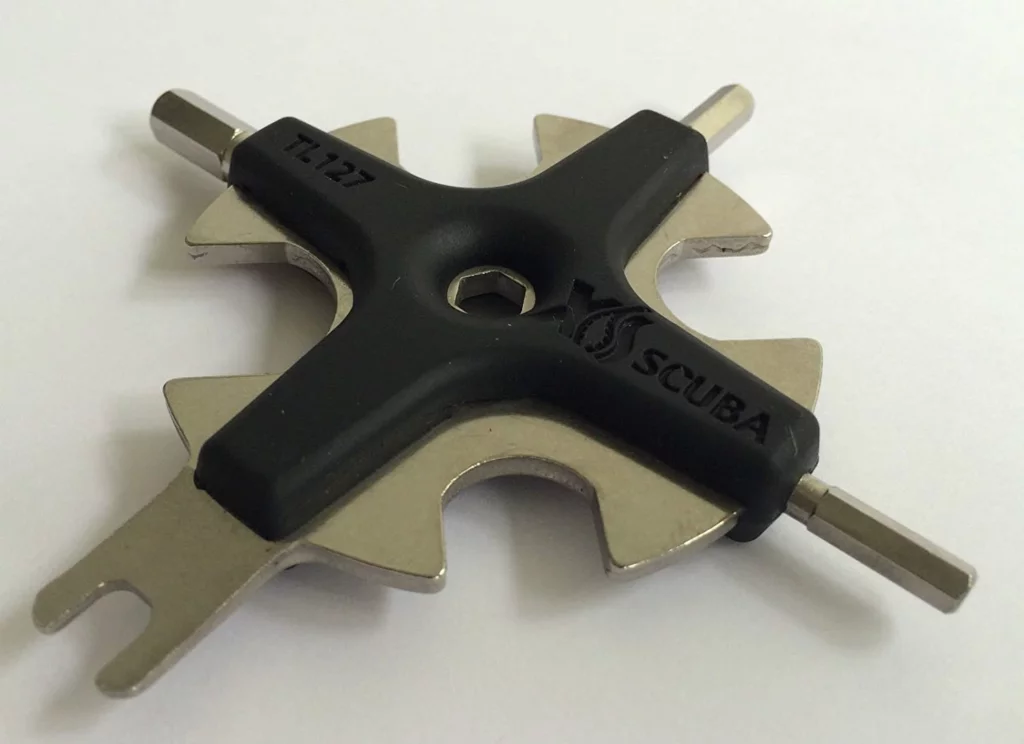
The XS Scuba Star Tool is an innovative tool for divers. This can either be kept in your tool kit or brought with you underwater in the event that you wanted to tighten a leaking first stage port or hose connection. Its small, compact size, as well as its versatility, make it the perfect tool for those wanting to save on size and weight.
Features
- Wrenches: 1/2”, 9/16”, 5/8” & 11/16”.
- Allen keys: 5/32”, 3/16” & 1/4”.
- Valve handwheel driver.
- Small, compact size.
- Made from stainless steel.
Scuba Choice Scuba Diving O-Ring Kit with Brass Pick with O-Rings Set (200-Piece)
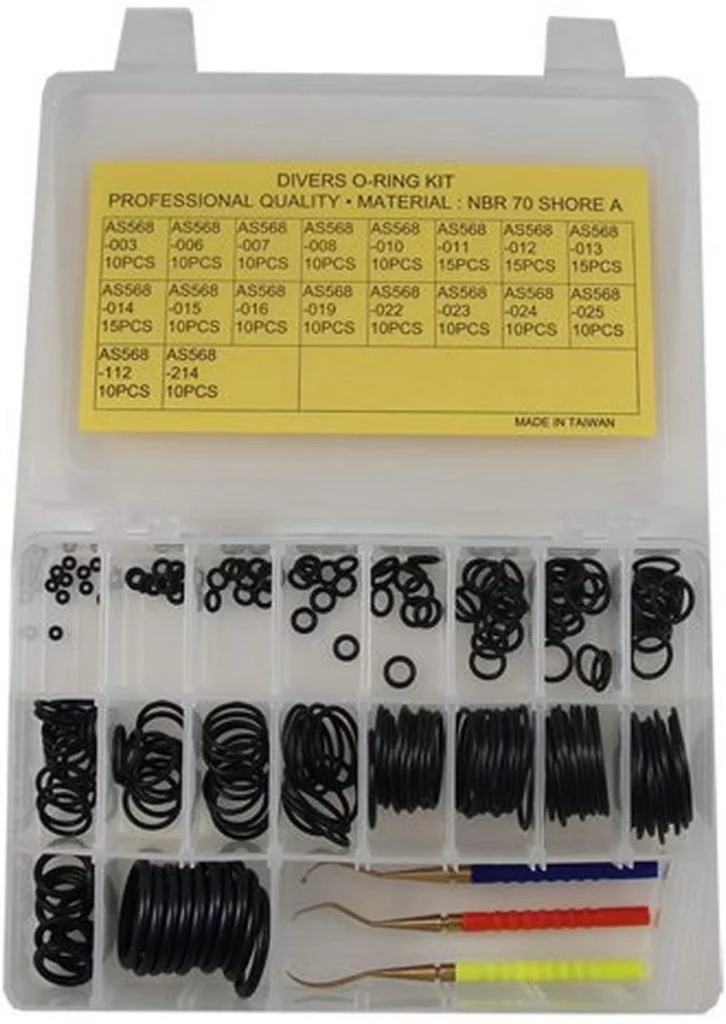
This o-ring set with three brass picks is an excellent supply for divers. This will likely last you and your dive buddies for years, and is a great spare kit to own, especially when diving alone or in remote environments.
Features
- Assortment of different sized o-rings for scuba regulators.
- Comes with three different sized brass o-ring picks for easier removal process.
#5 Wetnotes
Scubapro X-TEC Waterproof Wet Notes Notepad
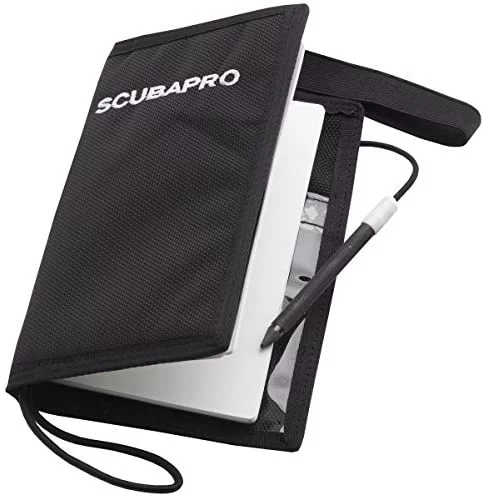
Scubapro’s X-Tec wetnotes are the perfect accessory for the diver wanting increased communication capacity. The notepad itself is slim with a loop of shock cord for boltsnap attachment, making it perfect to place inside a thigh cargo pocket. It also comes with an attached pencil, as well as two transparent pockets accommodating tables or any other additional accessories that can fit inside. The nylon cover, the pencil and the sheets of paper are all fully replaceable, making this a long-lasting piece of equipment for the committed diver who too is in for the long-run.
Features
- Features a 1000 denier replaceable nylon cover and replaceable underwater paper.
- The elastic bookmark allows you to mark a place for quick reference.
- Included: a pencil holder and a secure closure loop with shock cord attachment for a boltsnap.
- Two clear pockets accommodate tables or any other accessories.
BONUS – Decanting Whip
Decanting Hose with Gauge
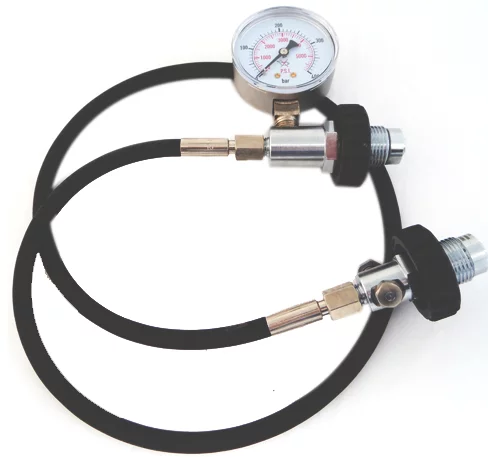
This 300 bar DIN decanting whip is the perfect accessory for the remote/self-sufficient diver and/or the sidemount diver. With the addition of a pressure gauge, you are able to know the exact gas pressure when equalising.
Features
- 300 bar DIN fitting.
- 400 bar pressure gauge.
Advice Guide
1 – DSMB
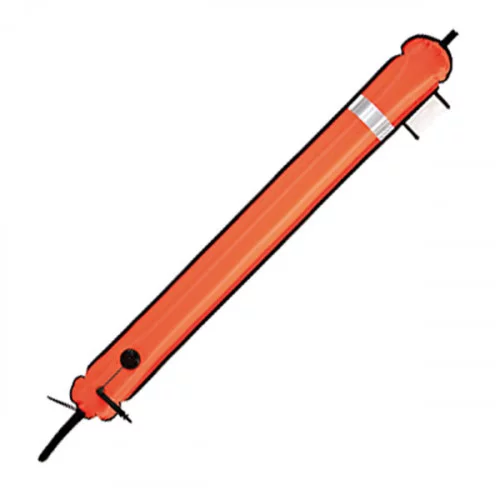
Perhaps one of the most important accessories, the Delayed Surface Marker Buoy (DSMB) will ensure both your safety and effectiveness as a diver. A DSMB is designed to mark the presence of divers below, allowing surface traffic to avoid the area. This enables you to make safe ascents in open water, without the fear of a boat colliding with you and your group on the surface. Similarly, a DSMB can also be lifesaver when making an ascent in the blue, as it gives you a visual point of reference.
But the dive guide always carries a DSMB, so why should I? you may ask.
True, a dive guide is required to carry a DSMB, but that doesn’t mean you shouldn’t. Becoming separated from the dive guide, particularly in some areas of the world, is not an uncommon event. It is not necessarily an emergency, and typically requires you to carry out the agreed upon separation procedure; search for one minute and then ascend, regrouping on the surface. However, without your own DSMB, carrying out the ascent and waiting on the surface can turn into a very dangerous act, particularly in open water environments with heavy boat traffic.
Well, my buddy always carries a DSMB for the both of us, so that works out then, right?
Just as guide separation is more common than we may expect, so too is buddy separation. The best buddy is the one who is self-reliant, as they will always be equipped to deal with the next problem confronting them; by implication, making the dive safer for you as their buddy. Additionally, in many areas of the world, the DSMB – alongside the dive computer – is becoming a mandatory piece of equipment for every diver to carry. Therefore, if you plan on diving with Oceanic Whitetips in Ras Mohammed, drift diving in Nusa Penida, or in any other adventurous dive sites around the world, then having your own DSMB is a given.
There are a range of features to consider when purchasing a DSMB, but – unlike with other pieces of dive equipment – they are all fairly straightforward to understand. When it comes to DSMBs – as a rule of thumb – more is usually better.
HEIGHT: The buoy itself comes in different sizes depending on brand. For diving in extreme conditions with high waves and/or poor surface visibility, you can buy a DSMB of up to 10 ft tall. However, for most types of diving this is overkill; a simple 4-6ft buoy should more than suffice.
COLOUR: DSMBs are most commonly available in red, yellow and orange. Although there exists no international maritime standards on DSMB colours in relation to meaning, it is common for colours to hold meaning in various regions and/or among various dive centres. For example, it is common in many areas for red/orange to signify that a safety/deco stop is taking place, thereby acting as a mere location marker for the divers. However, a yellow DSMB in these areas signifies some sort of emergency, usually relating to decompression problems (e.g. not enough gas to complete required deco). These divers would thus carry two DSMBs; a red/orange one, and a yellow one. Therefore, it is wise to consider where you are going to be diving before deciding on the colour of your DSMB. Protocols vary from region to region. That said, however, the most important factor is that it is clearly visible.
INFLATION METHOD: There are three different ways to inflate a DSMB: orally, with your second stage, or with your low pressure inflator hose. Different methods are preferred by different divers, however, there is a growing consensus – certainly within the technical diving community – that oral inflation proves to be the most effective and safe method of inflation.
DSMBs are designed for different inflation methods. If a DSMB is ‘open-ended’ – i.e. there is a small hole at the base of the buoy – then this is designed for second stage inflation. Equally, some DSMBs are ‘closed’ and come with a plastic aeration tube. This is for inflation via the mouth and/or the low pressure inflator hose. Whilst both methods of inflation are effective, open-ended DSMBs present two problems.
Firstly, when the DSMB is deployed, the diver must ensure that constant tension is kept on the spool line. If not, the DSMB will fall flat on the surface, potentially allowing the air to escape from it. This could result in a total DSMB failure, defeating the entire purpose of deploying one; in the worst case, surface support and/or other boat traffic may not see your buoy and could either lose or collide with you on the surface.
Secondly, an open-ended DSMB requires you to place your second stage regulator between the base of the buoy and the webbing attaching to the lower D-ring; from this point, you hold the purge button, rapidly inflating the buoy. Therefore, you have to be able to quickly remove the second stage from underneath the DSMB, ensuring the hose is not in any way entangled before launching the buoy to the surface. Clearly, this procedure carries risk, and I myself have seen countless divers entangle themselves during the inflation process, almost pulling themselves to the surface along with their DSMB (beginners and instructors alike!).
Ultimately, what inflation method you choose to use is up to you, and all are acceptable methods. However, in the name of optimising safety and efficiency, I personally would recommend purchasing a closed DSMB with an aeration tube.
SPOOL: Not all spools are created equal. The spool is attached to the lower D-ring on the buoy and allows you to maintain hold of the buoy when deployed, as well as enabling you to keep tension on the buoy so that it stands upright on the surface (ensuring that you are seen). For the purposes of DSMB deployment, the spool you want is a ‘finger spool’.
A spool is usually composed of either nylon braided line or string; the former is preferable and used in the highest quality spools. They come in varying lengths; some are as short as 6m, some go up to 100m. For most types of diving, a spool in the range of 15-45m will suffice. It is also recommended to purchase a spool that does not come full to the edges with line. The reason for this is that it makes securing the double-ender in the spool hole near impossible and can also increase the likelihood of the spool becoming jammed during unwinding.
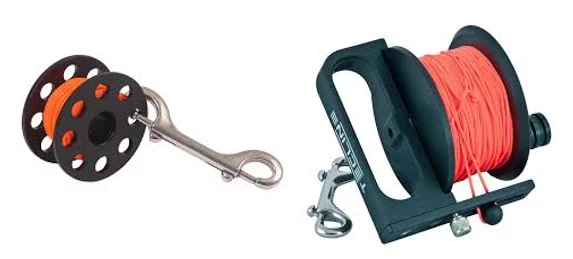
ACCESSORIES: Different types of DSMB come with additional features. Many come with reflective stripes to increase visibility on the surface when sunlight or search lights are shone on them. Similarly, some come with an attachment point at the top for fixing a light stick to for night diving. Some DSMBs also have pockets which can fit a slate or wet-note sized page into. These are particularly useful for those involved in technical diving, utilising a surface support crew. For example, if a deco gas had been lost or there was an increased amount of decompression than was planned for, the divers would be able to send up a DSMB with a slate explaining the situation, requesting more deco gas to be sent down to them. All of these additional features are very useful, however, they are not strictly necessary in all situations for all divers. The key in selecting a DSMB is purchasing one which will be highly visible when deployed in the environment you will be diving in.
2 – Dive Knife

A good dive knife is an essential piece of equipment for every diver. A knife is a life-saving tool which can free you or your buddy from an entanglement, slice through anchor lines, or even cut through discarded fishing nets. Some divers often talk of dive knife size in relation to experience, i.e. smaller knives for beginners, with experienced professionals being allowed to wield sword-sized blades. This is a common fallacy. A dive knife does not need to be big with a razor-sharp tip in order for it to be effective; in fact, smaller, blunt-tipped blades are often the better choice. For an in-depth guide on the best dive knives, check out our article which covers everything from blade metal, to length, through to placement and storage options.
3 – Compass
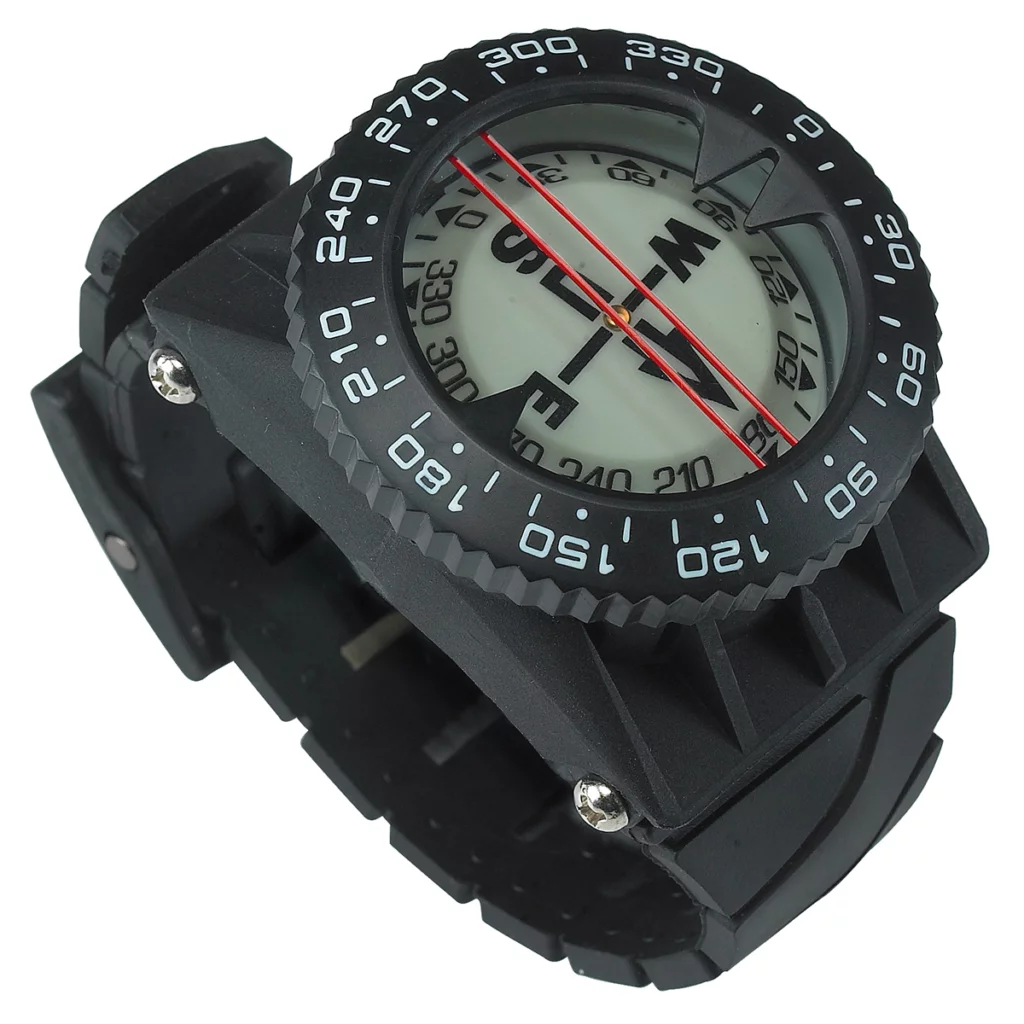
The compass is political in the diving community; some love it, others despise it. However, for anyone who’s had to navigate in low visibility, or in the blue in open ocean, they know the true value of a compass. Compasses are a relatively simple purchase, but there are a few things to look out for.
TILT COMPENSATION: In order for a normal compass to work, it must be held level. In the underwater world, this is easier said than done. Therefore, the best underwater compasses have tilt compensation, allowing the compass to function whilst not fully level.
SIDE VIEW WINDOW: A good underwater compass comes with a side-view window. This is simply – as the name describes – a small window on the side of the compass, meaning you can look forward whilst navigating rather than having to continuously look down to check your heading. This is a useful feature that you should look out for when selecting an underwater compass.
READABILITY: An often neglected aspect of compass selection, being able to actually read it is somewhat essential! Many compasses are designed to be luminescent when diving at night/in dark water – this is an excellent feature and will prove well for all diving environments.
MOUNTING: Wrist mounted, retractable, hose clipped – there are a multitude of options for mounting your compass. Whilst all have their pros and cons, wrist mounting is arguably the best option. The compass is exactly where you need it, it requires no moving of equipment to use it and it is not confused in other places of your configuration. That said, however, this is mostly a matter of personal preference. Just make sure to consider how you plan to mount the compass before purchasing it.
4 – Spares & Tool Kit

Commonly referred to as a ‘save-a-dive’ kit, a spares and tool kit is a great accessory to have with you at the dive site – specifically at the dive site; not left in your hotel room, or back in your suitcase at the dive centre! Depending on your equipment and the type of diving you are engaged in, your spares and tool kit will likely differ from the next diver. However, there are some essentials that all divers should have, regardless of equipment or the type of diving.
O-RINGS: O-rings make up almost all of the equipment we use in diving, so – as a spare part – they are essential to have with you. There are many different sizes of O-rings for different purposes. Generally, at minimum, you want to have spare o-rings for the plugs in your first stage and well as for the end of the thread of your DIN regulator – or for the tank insert if using a Yoke fitting. Aside from these, you need to consider what other pieces of equipment you are carrying in which an o-ring failure would lead to you having to skip the dive. Dive light o-ring? Camera housing o-ring? Swivel spg o-ring? The choice is yours. There are many o-ring sets with a collection of various sizes. These are ideal for your spares kit.
MOUTHPIECE: A spare mouthpiece for your second stage is always a good thing to have with you. It’s so simple, yet can be the difference between skipping a dive or not.
CABLE TIES: Cable ties can be used in a variety of different ways, even to fix things you didn’t think were fixable. Primarily, they come in handy for securing a new mouthpiece to a second stage, and also for making a breakaway boltsnap connection on regulator hoses. But they can be used for many more things, and are always handy to have with you, especially for quick temporary fixes.
WRENCHES AND AN ADJUSTABLE WRENCH: Various sizes of wrench as well as an adjustable wrench, are a must have in a ‘save-a-dive’ kit. These will allow you to change and/or tighten a malfunctioning regulator hose, among many other quick fixes. There are many companies selling tool kits made for diving which come with the correct sizes of wrenches for different jobs.
ALLEN KEYS: A good set of allen keys will allow you to tighten and/or remove plugs from your first stage. This is an easy job that can save you from a bubbling first stage.
SILICONE DRYSUIT SEALS: This, of course, only applies if you are diving with a drysuit with replaceable silicone seals. If you are, then having a spare pair of wrist seals as well as a neck seal is invaluable in ensuring you don’t have to miss a dive because of a busted seal. Remember, it is not a matter of if a seal breaks; it is a matter of whenMULTITOOL: There are a variety of multitools available on the market. Most include allen keys and wrench heads, with some even coming with o-ring picks and screwdriver heads. This is a great option if you would prefer to carry something smaller, rather than a set of multiple wrenches and allen keys. Moreover, they are the perfect choice for the travelling diver who wants to save on size and weight.
SILICONE GREASE: This can come in handy in a variety of ways, but particularly for the lubing up of o-rings. A small jar will last you for a long time.
HP HOSE/LPI HOSE/REGULATOR HOSE: A spare hose for each part of your regulator is always a good idea. They can break unexpectedly, and will guarantee a missed dive. Although they may be slightly harder to carry with you, they are an invaluable accessory to have.
There are many more items that could be included. I have left medical products out, such as sea sickness tablets and basic first aid supplies, as it is primarily a spares and tool kit. However, these items are of course also essential to have with you, especially if you are diving alone and/or in a remote location. Similarly, spare pieces of equipment, such as a back-up mask, would also be smart to carry with you, alongside extra boltsnaps and double enders (especially if diving sidemount and/or with stages).
5 – Wetnotes
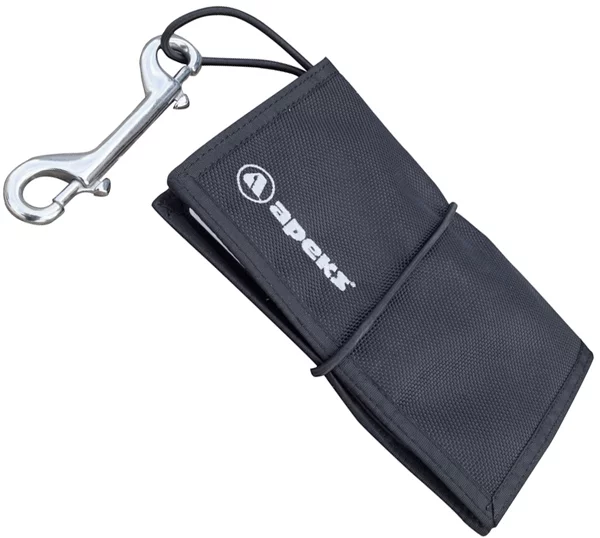
Sometimes seen as the preserve of instructors and technical divers, wetnotes are a great piece of equipment that can be very useful in overcoming communication problems at depth. In the eyes of many, one of the luxuries of scuba diving is that no one can talk to you, and this is certainly true. However, it can also present itself as a problem. This reduced ability to communicate can turn misunderstanding into confusion and problems into emergencies. Therefore, being able to write what you want to communicate is invaluable in overcoming one of the biggest challenges of the underwater world.
Wetnotes usually come in the form of a book, with multiple pages for writing. These can be used simply in situations in which normal communication with hand signals is insufficient. Similarly, you can write contingency plans and/or messages in advance of the dive, so that you can always have them with you and can quickly access and refer to them in an emergency. If the sound of a book puts you off, (although it is very slim) then you can always go for just a simple double-sided slate.
Wetnotes and/or slates are best stored in the thigh cargo pocket of a drysuit or in technical neoprene shorts (worn over a wetsuit). By storing them in this manner, your configuration remains decluttered and streamlined. Failing that, using a BCD pocket will suffice.
Bonus – Decanting Whip
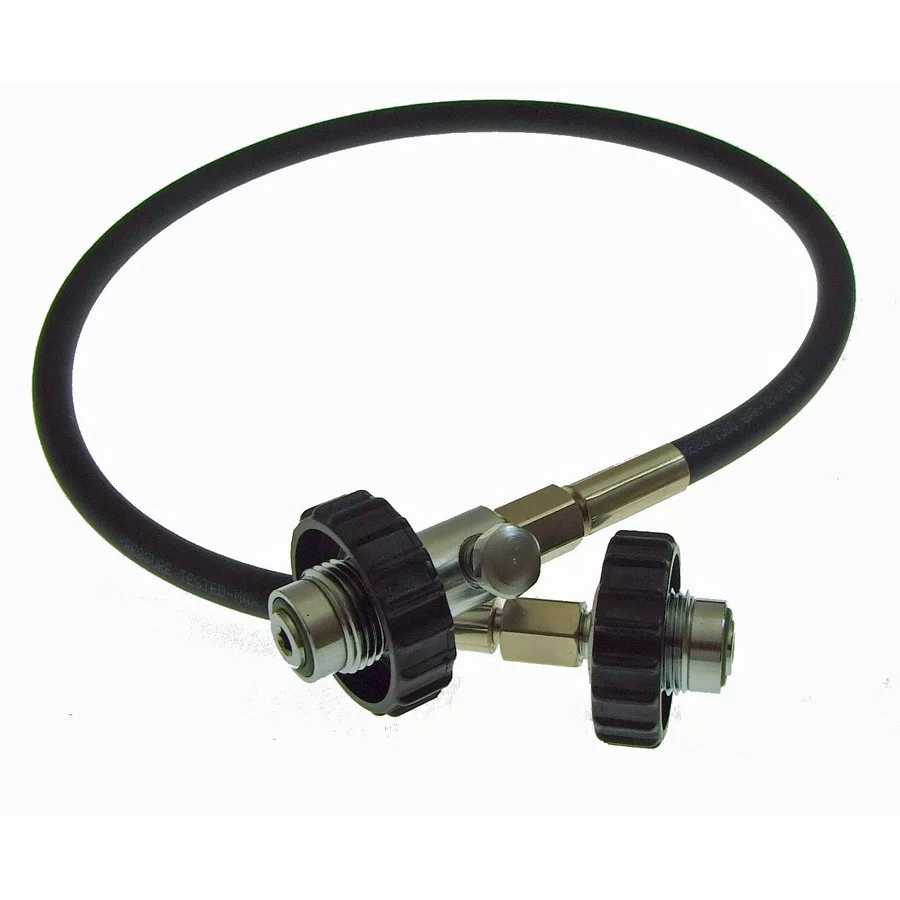
Probably one of the last pieces of equipment that comes to mind when talking about dive accessories, a decanting whip is an invaluable tool. A decanting whip allows you to transfer higher pressure gas from one tank into a tank with a lower gas pressure, causing both to equalise at the same pressure. For diving in remote environments where self-sufficiency is necessary, a decanting whip is of paramount importance. For example, after completing a dive, if your buddy’s tank is significantly lower in gas pressure than yours is, you can simply connect and equalise the tanks, making your gas volumes equal to each other for the next dive. Similarly, it can also come in very handy for sidemount divers conducting repetitive dives. If you forgot to regularly switch between tanks throughout the first dive, you can connect the two and equalise them, meaning that the buoyancy characteristics will be the same for the second dive, without having to change tanks or suffer through extreme buoyancy differences between left and right.